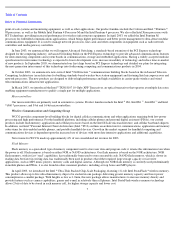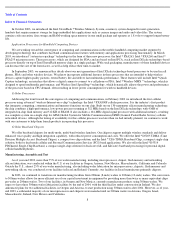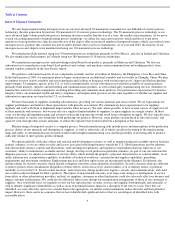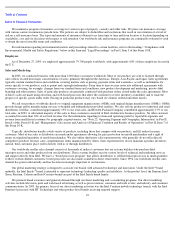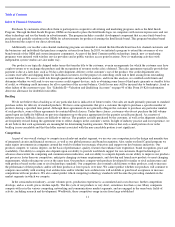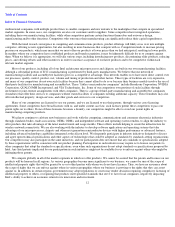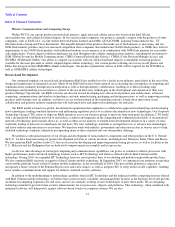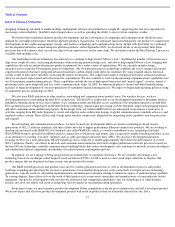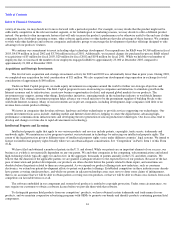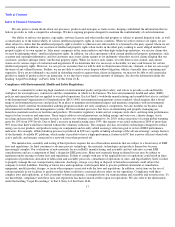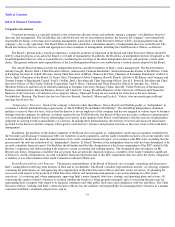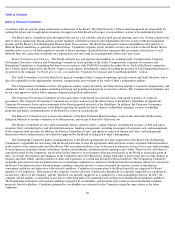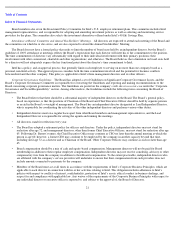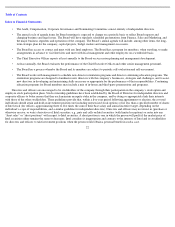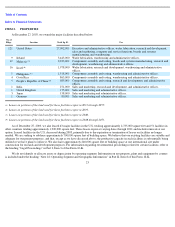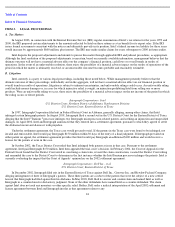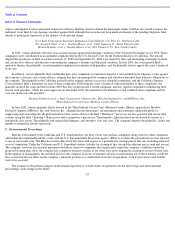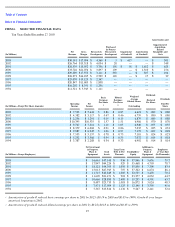Intel 2003 Annual Report Download - page 20
Download and view the complete annual report
Please find page 20 of the 2003 Intel annual report below. You can navigate through the pages in the report by either clicking on the pages listed below, or by using the keyword search tool below to find specific information within the annual report.
Table of Contents
Index to Financial Statements
We also protect certain details about our processes, products and strategies as trade secrets, keeping confidential the information that we
believe provides us with a competitive advantage. We have ongoing programs designed to maintain the confidentiality of such information.
Our ability to enforce our patents, copyrights, software licenses and other intellectual property is subject to general litigation risks, as well
as uncertainty as to the enforceability of various intellectual property rights in various countries. When we seek to enforce our rights, we are
often subject to claims that the intellectual property right is invalid, is otherwise not enforceable or is licensed to the party against whom we are
asserting a claim. In addition, our assertion of intellectual property rights often results in the other party seeking to assert alleged intellectual
property rights of its own against us. Like many companies in the semiconductor and other high-technology industries, we receive claims that
we may be infringing others’ intellectual property rights. In addition, our sales agreements often contain intellectual property indemnities, such
as patent and copyright indemnities, and our customers may assert claims against us for indemnity when they receive claims alleging that our
customers’ products infringe others’ intellectual property rights. When we receive such claims, we refer them to our counsel, and current
claims are in various stages of evaluation and negotiation. If we determine that it is necessary or desirable, we may seek licenses for certain
intellectual property rights. However, we can give no assurance that we will be able to obtain licenses from any claimant, or that we can accept
the terms of any offered licenses. Further, we are not able to resolve every dispute without litigation, which is typically time-consuming and
expensive. If we are not ultimately successful in defending ourselves against these claims in litigation, we may not be able to sell a particular
product or family of products due to an injunction, or we may have to pay material amounts of damages. See also the information under the
heading “Legal Proceedings” in Part I, Item 3 of this Form 10-K.
Compliance with Environmental, Health and Safety Regulations
Intel is committed to achieving high standards of environmental quality and product safety, and strives to provide a safe and healthy
workplace for our employees, contractors and the communities in which we do business. We have environmental, health and safety (EHS)
policies and expectations that are applied to our global operations. Each of Intel’s worldwide manufacturing and assembly/test sites is certified
to the International Organization for Standardization (ISO) 14001 environmental management system standard, which requires that a broad
range of environmental processes and policies be in place to minimize environmental impact and maintain compliance with environmental
regulations. Intel’s internal environmental auditing program includes not only compliance components, but also modules on business risk,
environmental excellence and management systems. We have internal processes that focus on minimizing and properly managing any
hazardous materials used in our facilities and products. We monitor regulatory trends and set company-wide short- and long-term performance
targets for key resources and emissions. These targets address several parameters, including energy and water use, climate change, waste
recycling and emissions. Intel remains on track to achieve our voluntary commitment to, by 2010, reduce emissions of certain global warming
gases by 10% from 1995 levels. Due to Intel’s increase in manufacturing since 1995, this equates to an actual reduction in 2004 of more than
90% from what Intel would have emitted without the voluntary reduction. The company also has several key technologies designed to reduce
energy use in our products and products using our components and recently added an energy reduction goal to its list of EHS performance
indicators. For example, all Intel desktop processors produced in 2003 are capable of taking advantage of the advanced energy savings features
of the Instantly Available PC platform, which makes it possible to have a high-performance, feature-rich PC that is power efficient when both
active and idle, and remains connected to a network even when powered off.
The manufacture, assembly and testing of Intel products requires the use of hazardous materials that are subject to a broad array of EHS
laws and regulations. As Intel continues to advance process technology, the materials, technologies and products themselves become
increasingly complex. Our evaluations of new materials for use in R&D, manufacturing, and assembly and test take into account EHS
considerations and are a component of Intel’s design for EHS processes. Many new materials being evaluated for use may be subject to
regulation under existing or future laws and regulations. Failure to comply with any of the applicable laws or regulations could result in fines,
suspension of production, alteration of fabrication and assembly processes, curtailment of operations or sales, and legal liability. Intel’s failure
to properly manage the use, transportation, emission, discharge, storage, recycling or disposal of hazardous materials could subject the
company to future liabilities. Existing or future laws and regulations could require Intel to procure pollution abatement or remediation
equipment, modify product designs, or incur other expenses associated with the laws and regulations. In addition, restrictions on the use of
certain materials in our facilities or products in the future could have a material adverse effect on our operations. Compliance with these
complex laws and regulations, as well as internal voluntary programs, is integrated into our manufacturing and assembly and test processes. To
our knowledge, compliance with these laws and regulations has had no material effect upon our operations. We also refer to the information
under the heading “Legal Proceedings” in Part I, Item 3 of this Form 10-K.
17


